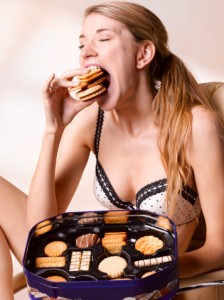
Experts estimate that around 75% of overeating is emotional, probably because many of us learn that eating can cause us to feel a little bit better, at least in the short term.
Eating can become a habit when we are sad or when we are happy, just as we may watch a happy film to cheer ourselves up when sad or turn to a loved one for comfort.
Emotional eating is not necessarily caused by sadness. We could overeat when bored, when happy, when sad, when stressed, when fatigued, when anxious or when lonely – any emotion you can think of, you could find yourself eating when you experience that emotion.
We probably turn to food when feeling different emotions simply because eating is something that is intrinsically linked with enjoyment. If we’re happy, we want to continue being happy by eating something yummy. If we’re sad, we want to make ourselves happy by eating something yummy. Eating a chocolate bar may instantly make you feel more cheery. Eating your particular favourite food will also make you feel better, as it is your favourite for a reason – because you enjoy eating it.
To work out if you are an emotional eater or not, try keeping a food diary. Write down everything you eat, when you’re hungry, when you eat, what you’re feeling when you eat and whether you were full or not after. Keeping a food diary will enable you to identify why you eat and when you eat because you’re feeling emotional, and this is the first step to breaking the emotional eating cycle.
How to stop emotional eating
Developing alternatives to your overeating is the next step. This doesn’t have to mean not eating at all when you feel an emotion, it can just mean choosing a different food. For instance, if chocolate is your emotional eating food of choice, buy mini chocolate bars so that you can control your portion. Try eating a handful of fresh berries or sweetened yoghurt if sweets are your trigger, and try some hummus with crudités if chips are your trigger. Whatever the trigger, there is an alternative.
You could also try displacement activities instead of replacing your food. For instance, when you feel emotional and you want to reach for that packet of biscuits, go on a walk or for a bike ride. Alternatively, you could do something to improve your self-confidence – try curling your hair, painting your nails, giving yourself a fake tan or having a bubble bath. You could also try playing games with your children, or you could play a board game with the family.
If distracting yourself doesn’t do the trick, then you could try practicing meditation techniques, relaxation techniques or breathing exercises. All of these things can help to calm your emotions and can help you to deal with any emotions you may be feeling more adequately. Alternatively, you could try counselling – speak to your doctor for more information.
Above all, as you learn to cope with your emotions instead of emotional eating when you feel a certain way, remember to reward yourself with something that makes you feel good. Take a vacation, buy that new pair of shoes you’ve been wanting to buy or take up that dance class – rewarding yourself in this way means you’ll be far more likely to stick with it.
And if you need to follow a weight loss plan to help give you structure around your diet then check out our 28 Day Diet & Exercise plan and don’t forget we also have our FREE weight loss members area here to help you stay on track.
